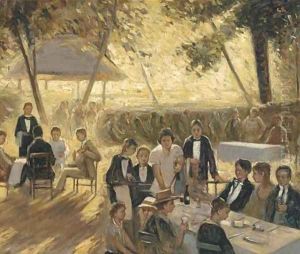William Jesmond Dewar Paintings
William Jesmond Dewar was a British artist known for his distinct contributions to the art world in the early 20th century. Born in 1884, Dewar's artistic journey began in an era marked by rapid social and technological changes, which significantly influenced the evolution of art in Europe. Despite the scant availability of detailed records about his early life and training, Dewar's work suggests a solid foundation in classical art techniques, combined with an appreciation for the emerging styles of his time.
Dewar's oeuvre is characterized by a versatility across mediums, including painting, illustration, and graphic design. He demonstrated a remarkable ability to adapt and evolve his style, reflecting the broader shifts in art movements from the late 19th to the early 20th centuries. His works often captured the essence of his subjects with a unique blend of realism and stylization, showcasing his skill in using color and form to convey mood and narrative.
Throughout his career, Dewar engaged with various themes, ranging from landscapes and portraits to scenes of daily life and fantastical compositions. This thematic diversity not only highlights his adaptability as an artist but also his keen observation of the world around him. His ability to depict the mundane in a way that elevates it to the subject of fine art speaks to his innovative approach to art-making.
Dewar's contributions to the art world were recognized in his time, and he participated in several exhibitions, both in the United Kingdom and abroad. However, like many artists of his era, the full appreciation of his work has grown posthumously, as art historians and critics continue to explore the depth and breadth of early 20th-century art.
William Jesmond Dewar passed away in 1941, leaving behind a legacy that, while perhaps not as widely recognized as some of his contemporaries, remains significant for its artistic integrity and the glimpse it offers into the transitional period of art he navigated. His works continue to be studied and appreciated by those who seek to understand the complexities and nuances of British art in the early 20th century.
